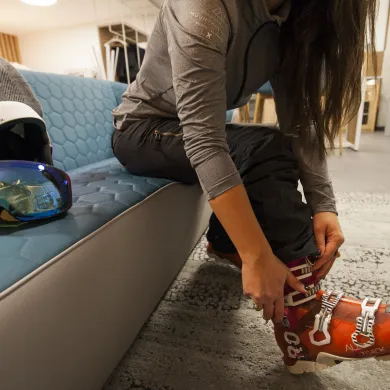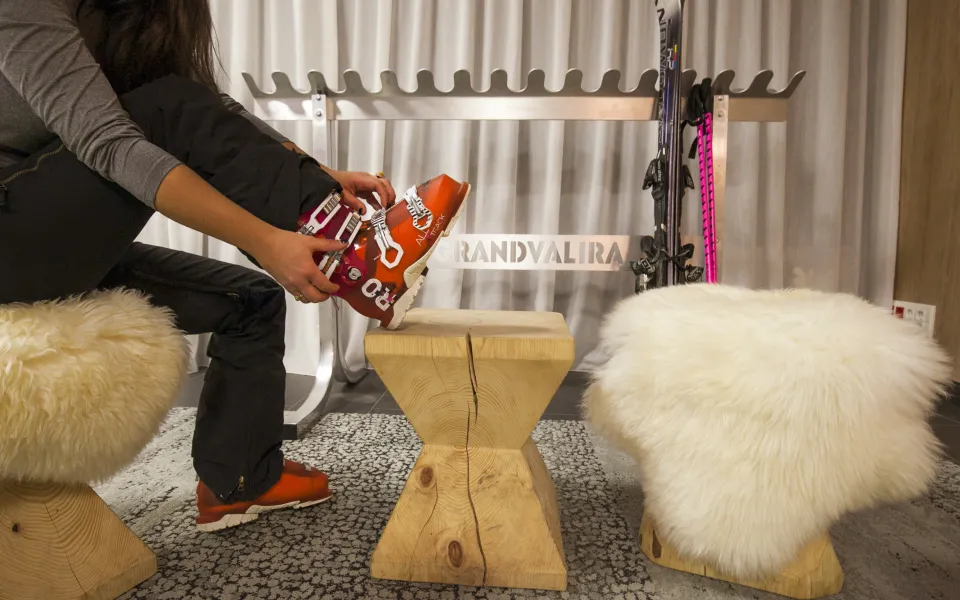
A holiday at a ski resort is a time to relax and to escape from everyday distractions, but planning what to wear skiing or remembering all of the equipment needed for alpine skiing can be a little stressful. To make your visit to a destination such as Grandvalira ski resort as easy as possible, we’ll outline in this guide exactly what to wear to a ski resort next time you escape for a winter vacation.
What ski equipment do I need?
One of the biggest choices to make when pondering what equipment do you need for alpine skiing is to decide if you’ll rent the actual skis, poles and bindings from the resort. If you’re more of a beginner, this is often the best option because those working on the slopes possess expert knowledge of all ski equipment and will fit you out with exactly what you need. Others prefer to bring their own skis, poles and bindings, which is absolutely fine too.
The other main pieces of ski equipment that are common to rent at the ski resort are the ski helmets and goggles, as these can be difficult to find and purchase elsewhere. Below, in this ski equipment checklist, we go through all the different pieces of ski equipment one by one.
Skis, poles, boots and helmet
The main four pieces of ski equipment that you’ll need are skis, poles, boots and a helmet. At most ski resorts, you won’t even be allowed to cross onto the slopes without these basic items for skiing. And, that makes perfect sense, as you need skis and poles to tackle the slopes, while a helmet is a safety must. These three items are usually best rented from the ski resort itself, but with skiing boots you might want to consider bringing your own.
What boots to wear for skiing?
When deciding what boots to wear for skiing, it is recommended that you tackle this before departing on your skiing or snowboarding holiday. That’s because it’s really important that the boots fit your feet perfectly and that they’re comfortable. Although it is possible to rent ski boots from a resort, they’re unlikely to be the perfect fit.
This means you should go shopping for your ski boots beforehand and it can be quite confusing for first-timers, as there are many different types. For alpine skiing, there are front-entry boots, rear-entry boots, side-entry boots and more. The most common type of skiing boot is the front-entry boot, which can also be called top-entry and which means the tongue opens forward to allow your foot to slide in from the top.
As long as your ski boot has grip, is waterproof and, most importantly, fits exactly, then it’ll do the job. Going one size up is not recommended when it comes to selecting your ski boots, as this can cause issues when binding to the skis.
Goggles
Another important item will be ski goggles. Why are ski goggles important? Well, it’s because they can protect you from little pieces of snow or other debris that might flick up from the slope, while the more advanced ski goggles also provide protection from the sunlight and from the cold air too.
Long underwear
You might not want to think much about your holiday underwear, but it is important to understand the importance of long underwear on a skiing holiday. Given the cold conditions of a ski resort, having a base layer that insulates you is essential. Good thermal long underwear for skiing will also help with moving sweat off your skin, which is another important step in terms of keeping warm and, ultimately, staying safe and healthy out there.
Thick socks
One of the most obvious items of ski clothing is to use thick socks. Given that your feet will be in contact with the cold surface, you’ll want to have thick socks to stay warm. With this, it’s important to make sure that your shoe size doesn’t change with this extra thickness.
Fleece
Just as with the thick socks around your feet, you’ll also want thick clothing around your upper body. Wearing a fleece, especially a skiing fleece, will ensure you don’t get cold up top.
Ski jacket
Over your fleece, you’ll want to wear a ski jacket. With this, it is absolutely vital that your ski jacket is waterproof. Given that you’ll likely fall over and hit the slope several times, the material of your ski jacket has to be waterproof so that the moisture of the snow doesn’t stick to you.
Long trousers
When we say here that you should wear long trousers, we mean long. Your skiing trousers should be long enough to reach and cover at least the top of your boots. If there is a gap, it can let in snow and that would be very uncomfortable.
Gloves
There are actually many different types of gloves and there are a few different kinds that can work for skiing, but the recommendation is that you prioritise waterproofness over picking the warmest gloves. You want to protect your hands from the snow, but you definitely don’t want moisture to stick to your gloves either.
Neck gaiter or balaclava
Essentially, you should be covered pretty much from top to toe when you set off skiing. As such, you’ll want to cover your neck too, using a neck gaiter or balaclava. These are usually quite cheap and come in all kinds of colours, to add a little more style to your skiing outfit.
Clothing tips for skiing
In terms of other more general clothing tips for skiing, it is recommended that you avoid cotton ski clothing, as this material isn’t waterproof and isn’t breathable. Wool is fine, though, as are all other waterproof items.
Also, make sure to dress appropriately for the climate of the ski resort which you’re visiting. Not every ski resort has the same climate and some will be warmer or colder, even if all have snow. For example, the climate at a ski resort in Andorra in the Pyrenean Mountains is fairly mild and there is even a lot of sun. With that in mind, make sure to pack some sunscreen too!
With all of this, it can add up to become quite a lot of skiing equipment, which is why there are ski lockers at Grandvalira. There, you can store all your ski equipment away at the end of a day on the slopes, so that you don’t have to carry it all around with you as you then enjoy the various après ski activities on offer.
